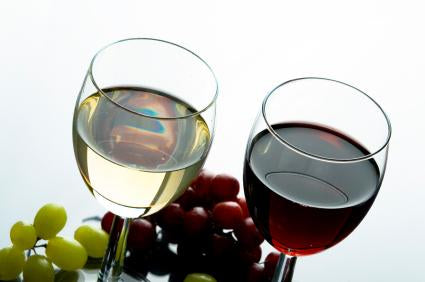
The main differences between red and white wines are fairly obvious: they have different colors, are made from different grapes, and typically contain different flavors. But there are also subtle differences between red and white wines that become apparent during and after the wine making process.
White Wine
When describing the flavor of white wines, there are two basic aspects to use: sweetness and acidity, both of which are found in the grapes used to make the wine. These two flavor descriptors vary in prominence depending on the type of grapes used, the growing process of those grapes, their ripeness, and other various things that can be found in wine making supplies.
The level of acidity (or tartness) and sweetness fluctuates based on the above factors, and is the determining factor in the type of wine created during the wine making process. Sweetness and acidity also help define the character and body of the wine. As a wine grape ripens on the vine, the sugars within begin transforming into other substances, including alcohol.
When these grapes are harvested, the amount of these substances and complex sugars in the grapes dictates the body of the wine being made. Thats how the finished product from your wine making kit doesnt have the consistency of flavored water. The higher the acid content in that wine, the longer its shelf life will be fresh from your wine making kit.
Red Wine
While the flavor of white wines is largely dependent on two factors, the flavor of a fresh batch of red wine from your wine making kit is determined by three factors: sweetness, acidity, and tannin. The latter aspect of red wine is what sets it apart from its white counterparts, and is essential in creating a great tasting red wine.
Any time you have a glass of red wine from your wine making kit, that dried out, puckered feeling in your mouth after every sip is caused by the tannin levels in the wine. Tannin is one of the easiest wine making supplies to find, and is the main reason why red wines tend to last longer on the shelf than white wines.
Tannin is located in the woody parts of the grape vine and in the grapes skin, and gets assimilated into the wine during the grape pressing process when the skin and stalks are soaked in the grape juice. This is on stark contrast to white wines, which rarely involves prolonged contact between the juices, skin, and grape stalks.
Any wine drinker knows some wines get better with age, and wines high in tannin can be harsh when opened early in its life. Let that same wine sit for a couple years, and the tannin levels smooth down and bring out some of the less prominent flavors in the red wine. Aging high tannin wine from your wine making kit is a great idea, and it will definitely make you stand out as a master wine maker among your friends and family.

 The main differences between red and white wines are fairly obvious: they have different colors, are made from different grapes, and typically contain different flavors. But there are also subtle differences between red and white wines that become apparent during and after the wine making process.
The main differences between red and white wines are fairly obvious: they have different colors, are made from different grapes, and typically contain different flavors. But there are also subtle differences between red and white wines that become apparent during and after the wine making process.
